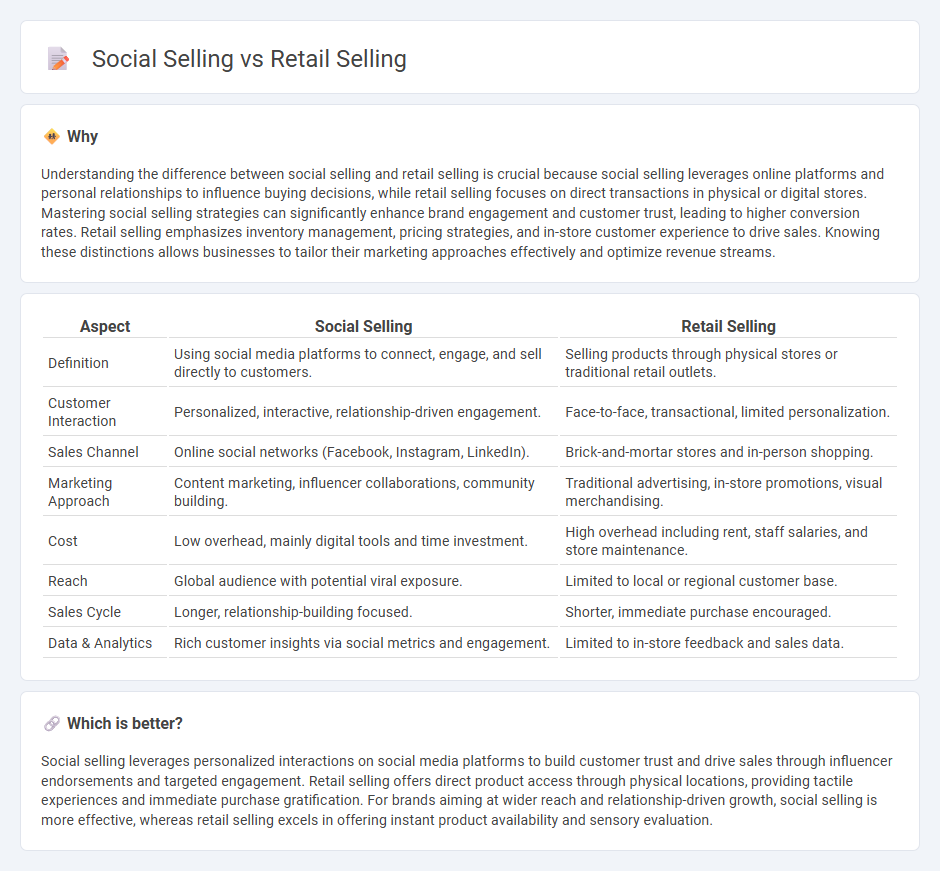
Social selling leverages digital platforms and social media to build relationships and engage customers directly, while retail selling primarily focuses on traditional in-store transactions and face-to-face interactions. Social selling utilizes data analytics and personalized communication to target specific audiences, enhancing customer experience and boosting conversion rates. Discover how integrating social selling strategies can transform your business and expand market reach.
Why it is important
Understanding the difference between social selling and retail selling is crucial because social selling leverages online platforms and personal relationships to influence buying decisions, while retail selling focuses on direct transactions in physical or digital stores. Mastering social selling strategies can significantly enhance brand engagement and customer trust, leading to higher conversion rates. Retail selling emphasizes inventory management, pricing strategies, and in-store customer experience to drive sales. Knowing these distinctions allows businesses to tailor their marketing approaches effectively and optimize revenue streams.
Comparison Table
| Aspect | Social Selling | Retail Selling |
|---|---|---|
| Definition | Using social media platforms to connect, engage, and sell directly to customers. | Selling products through physical stores or traditional retail outlets. |
| Customer Interaction | Personalized, interactive, relationship-driven engagement. | Face-to-face, transactional, limited personalization. |
| Sales Channel | Online social networks (Facebook, Instagram, LinkedIn). | Brick-and-mortar stores and in-person shopping. |
| Marketing Approach | Content marketing, influencer collaborations, community building. | Traditional advertising, in-store promotions, visual merchandising. |
| Cost | Low overhead, mainly digital tools and time investment. | High overhead including rent, staff salaries, and store maintenance. |
| Reach | Global audience with potential viral exposure. | Limited to local or regional customer base. |
| Sales Cycle | Longer, relationship-building focused. | Shorter, immediate purchase encouraged. |
| Data & Analytics | Rich customer insights via social metrics and engagement. | Limited to in-store feedback and sales data. |
Which is better?
Social selling leverages personalized interactions on social media platforms to build customer trust and drive sales through influencer endorsements and targeted engagement. Retail selling offers direct product access through physical locations, providing tactile experiences and immediate purchase gratification. For brands aiming at wider reach and relationship-driven growth, social selling is more effective, whereas retail selling excels in offering instant product availability and sensory evaluation.
Connection
Social selling leverages social media platforms to build relationships and engage customers, which directly influences retail selling by driving foot traffic and boosting in-store purchases. Retail selling benefits from social selling through enhanced brand awareness and personalized recommendations, leading to higher conversion rates. The integration of social selling strategies with traditional retail selling creates a seamless omnichannel experience that increases customer loyalty and sales revenue.
Key Terms
Point of Sale
Retail selling relies heavily on physical point of sale locations where customers can interact with products and complete purchases in person, emphasizing in-store experience and visual merchandising. Social selling leverages digital platforms and social media channels to engage potential buyers through personalized content and direct communication, driving sales without the need for a traditional storefront. Explore how integrating both methods can maximize customer reach and sales performance.
Influencer Marketing
Retail selling relies on direct transactions between brands and consumers through physical or online stores, while social selling leverages social media platforms to engage customers and build trust via influencers. Influencer marketing plays a pivotal role in social selling by using credible personalities to promote products authentically, driving higher conversion rates and brand loyalty. Discover how integrating influencer marketing can transform your sales strategy and amplify your brand presence.
Customer Engagement
Retail selling primarily relies on physical interactions and point-of-sale experiences to engage customers, often emphasizing product availability and in-store promotions. Social selling leverages social media platforms and digital networks to build relationships, personalize communication, and foster trust through content sharing and direct messaging. Explore deeper strategies to enhance customer engagement through these evolving sales models.
Source and External Links
Retail Sales Definition, Categories & Techniques - Lesson - Study.com - Retail selling is the process of selling goods in small quantities to the general public for personal use, involving key steps such as opening the sale, probing customer needs, demonstrating product value, handling objections, closing, and confirming the sale.
Retail - Wikipedia - Retail involves selling goods and services directly to consumers in smaller quantities, with retailers acting as the final link in the supply chain, and includes considerations like store type, product mix, customer service, and market positioning.
Selling in Retail: 9 Tips for Success as a Salesperson | Indeed.com - Effective retail selling includes making a strong first impression, asking personalized questions to understand customer needs, practicing active listening, and reading body language to boost sales success.
 dowidth.com
dowidth.com